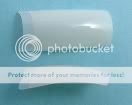geeg
Judge Gigi-Honorary Geek
Jaydee said:As the blended tip would be flush with the natural nail, I would presume that it is less likely than a tip that has that little step from the natural nail and tip.
David
You are right David.
A tip that is just sitting on top of the natural nail is far more likely to break down than a tip that encloses the natural free edge and protects it in a snug little well.
I also think that the well helps to guide the tips in a perfectly straight direction when they are being applied and cannot see how a wellless tip can be easier to apply to oneself than one with a well that guides it where it wants to go.
All this pre blending and filing would take more time for me than just getting it on the nail and quick blend and away you go.
I think it is all a matter of experience. Use your Raptors for a while until you can do good smiles using your different colored powders. I bet that when you return to a tip with a well you'll find it a piece of cake!
It sounds like most are using these tips because they don't want to create their own smiles and can't be bothered with blending! Which is what I suspected. Can't see one single other point anyone has made in favor of using them other than that. Which is fine for you maybe ... but the natural nail showing would really annoy me and I would tend to pick at it too. Plus the hygiene thing, and the fact that I like to 'create' a smile line that suits the client not be dictated to by the shape of the tip. These are my opinions.





